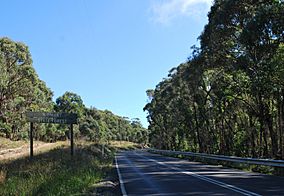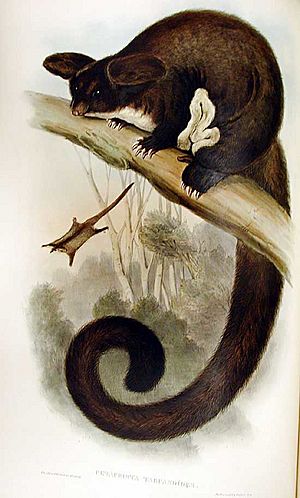Wombat State Forest facts for kids
Quick facts for kids Wombat State Forest |
|
|---|---|

Entering the Wombat State Forest, south of Blackwood
|
|
| Location | Victoria, Australia |
| Nearest city | Daylesford (formerly Wombat) |
| Area | 70,000 hectares (170,000 acres) |
| Established | 1871 |
| Governing body | Department of Sustainability and Environment |
The Wombat State Forest, also known as the Bullarook Forest, is a large natural area in Victoria, Australia. It is about 50 kilometres (31 mi) west of Melbourne. You can find it between the towns of Woodend and Daylesford. This forest sits on the Great Dividing Range, a chain of mountains in Australia.
The Wombat State Forest covers a huge area of about 70,000 hectares (170,000 acres). That's like 70,000 football fields! It was officially created in 1871. The forest is looked after by the Department of Sustainability and Environment. They make sure the forest stays healthy. They also manage things like getting firewood, protecting water, and keeping the plants and animals safe. The forest is also important for history, learning, tourism, and fun outdoor activities.
Contents
Forest History: From Gold Rush to Today
"This forest was the testing ground for techniques, ideas and attitudes that shaped resource management and sawmilling well into the twentieth century." (Forest historian Norm Houghton)
Long ago, the Dja Dja Wurrung people lived in the area that is now the Wombat State Forest. Before Europeans arrived, the forest was even bigger than it is today.
19th Century: Gold and Logging
In the mid-1800s, Australia had a big gold rush. Many people came to find gold. The Wombat Forest was heavily logged during this time. People cut down many trees. The wood was used for many things. It supported tunnels in mines and made tracks for tramways. It also lined mining shafts and fueled boilers for the mines. Wood was also used for piers, docks, and electric poles.
In 1860, a law called the 1860 Land Act was made. This law started to limit how many trees could be cut. Then, in 1871, the Wombat State Forest was officially set up. By 1884, there were 36 sawmills working in the Wombat and Bullarook Forests. Wood was sent to big cities like Melbourne, Sandhurst (now Bendigo), and Ballarat. Sadly, not many new trees were planted. Young trees were often burned. Because of this, the forest was badly damaged. Eventually, people stopped cutting timber there.
20th Century: Regrowth and Community Care
After the gold rush ended, the forest slowly started to grow back. By the 1960s, people began to carefully cut some trees again. This was done to help the forest become healthier. In the 1970s and 80s, the area was called the "Midlands Forest Management Area." During this time, pine trees were planted for commercial logging.
In 2001, local people shared their own ideas about how to manage the forest sustainably. This was a big step. It was one of the first times a community helped plan how a state forest should be managed. In 2010, some people worried that logging might start again. This was because the government gave out new logging licenses in western Victoria.
Forest Geography: Mountains, Volcanoes, and Springs
The Wombat Forest is split by the Great Dividing Range. This means the forest grows on both sides of the mountain range. It stretches from Creswick to Mount Macedon. The area around the forest has many old volcanoes. There are about 400 extinct volcanoes in a stretch from Kilmore in the north to Mt Gambier in South Australia. Some of these volcanoes, like Mount Babbington, Mount Wilson, and Blue Mount, are right inside the Wombat Forest.
The rocks in the forest are very old. They formed during the Palaeozoic era. Some parts of the forest have volcanic rocks called Quaternary basalts. These areas were cleared for farming a long time ago. But other parts have older soils that are not good for farming. These areas have stayed as forest. Over millions of years, the forest has changed. It went from a wet rainforest to a dry sclerophyll forest.
The Wombat State Forest is also where several rivers begin. These include the Lerderderg, Campaspe, and Loddon rivers. A very special part of the forest is its many mineral springs. About 80% of Australia's mineral springs are found here! The water from these springs is full of good minerals like calcium, silica, magnesium, iron, and sulphur. The old volcanoes in the area add carbon dioxide to the water. This makes bubbles come out of the springs, which is really cool to see!
Forest Life: Amazing Animals and Plants

The Wombat State Forest is home to many different kinds of animals and plants. It's a great place to learn about nature!
Fauna: Animals of the Wombat Forest
The forest is home to many native animals. You can find marsupials (like kangaroos and possums), monotremes (like echidnas), reptiles, amphibians, bats, and many kinds of birds. The Greater Glider (Petauroides volans) is the biggest possum in this forest. It lives in the western part of the Wombat State Forest.
Several rare or threatened bird species also live here. These include the Great Egret, Intermediate Egret, Grey Goshawk, Australian Masked Owl, Powerful Owl, and Square-tailed Kite. You might also spot the Red-browed Treecreeper and Olive Whistler in the trees.
Flora: Plants of the Wombat Forest
The Wombat Forest has a wide variety of plants. There are small, medium, and tall trees. You'll also find shrubs of different sizes, climbing plants, native herbs, grasses, and ferns. Many beautiful lilies and orchids grow here too. The main part of the forest is an open forest. It has many types of eucalypt trees. Some common ones are Messmate (Eucalyptus obliqua), Broad-leaf Peppermint (E. dives), and Narrow-leaf Peppermint (E. radiata). You can also see Manna Gum (E. viminalis) and Candlebark (E. rubida). In some areas, you might find Swamp Gum (Eucalyptus ovata) and Yarra Gum (E. yarraensis).
A fungus called Armillaria luteobubalina has been found in the forest. This fungus can cause trees to die. The forest has 111 different types of fungi. These include native and introduced species, plus some special fungi called lichenised fungi and myxomycetes (which are also known as slime moulds).
Some plants in the Wombat Forest are rare or threatened. These include the Wiry Bossiaea (Bossiaea cordigera) and Matted Flax-lily (Dianella amoena). Other special plants are Brooker’s Gum (Eucalyptus brookeriana), Fryerstown Grevillea (Grevillea obtecta), and Creeping Grevillea (G. repens). There are also two types of plants found only in the Wombat Forest: Wombat Leafless Bossiaea (Bossiaea vombata) and Wombat Bush-pea (Pultenaea reflexifolia).
Fun Things to Do in Wombat State Forest
The Wombat State Forest is a great place for visitors! There are many cool spots to explore. You can visit the Lyonville Mineral Springs, where you can see the bubbly mineral water. The Garden of St Erth is another beautiful place to enjoy nature. You can also take a walk along the Lerderderg Heritage River Walk. Nolans Creek Picnic Area is perfect for a family picnic.
The forest also has many historic places. You can see Andersons Mill, Balt Camp, Pioneer Sawmill, and Yankee Mine. These places tell stories about the forest's past. There's even a heritage diesel railway in the forest, which is a fun way to see the sights!
Images for kids


